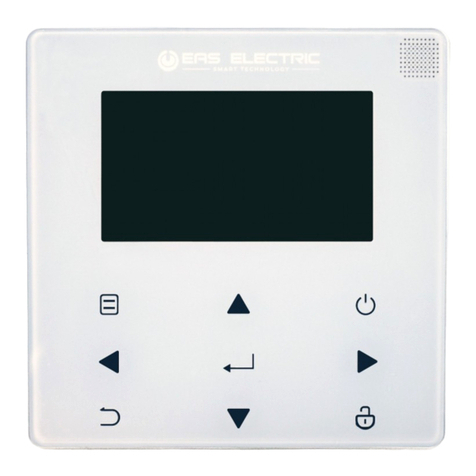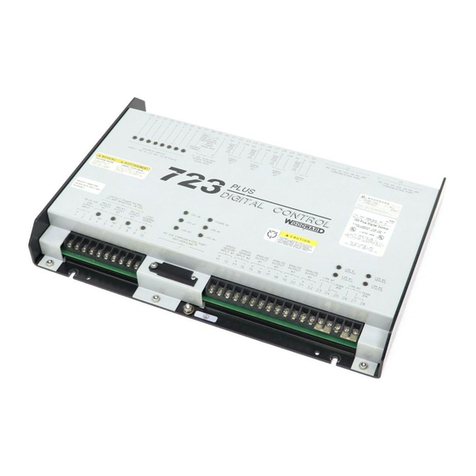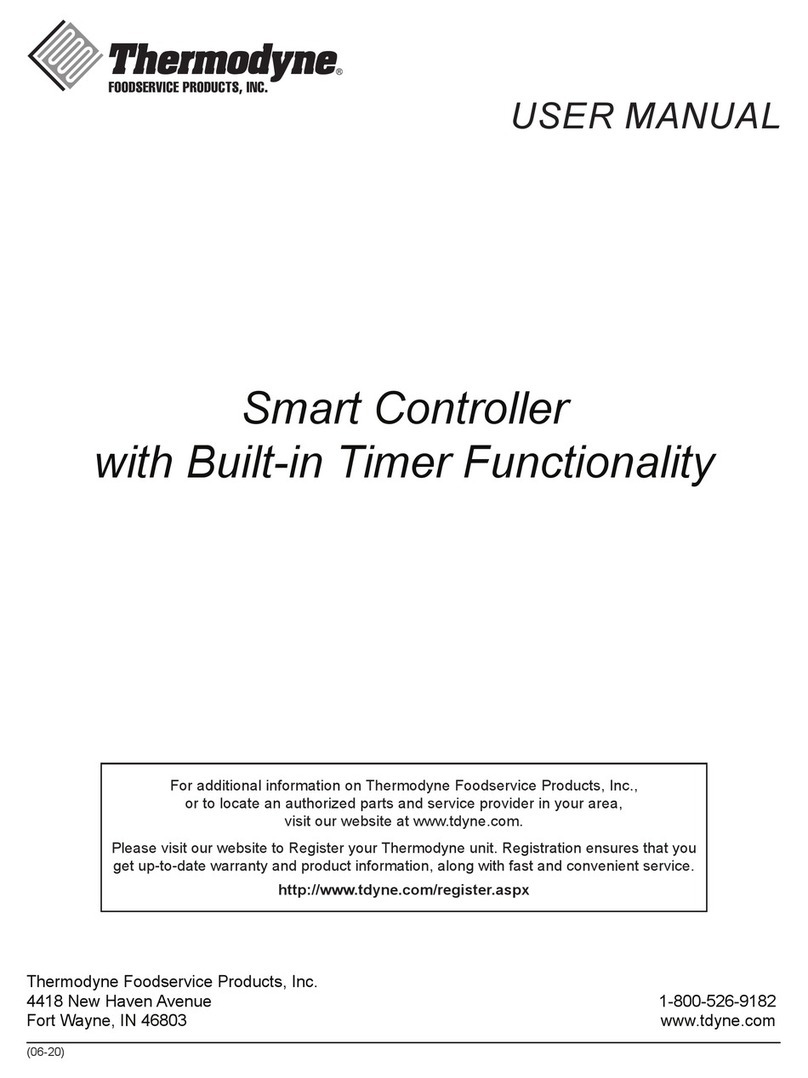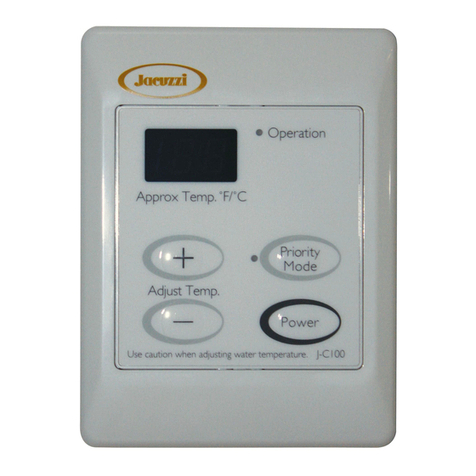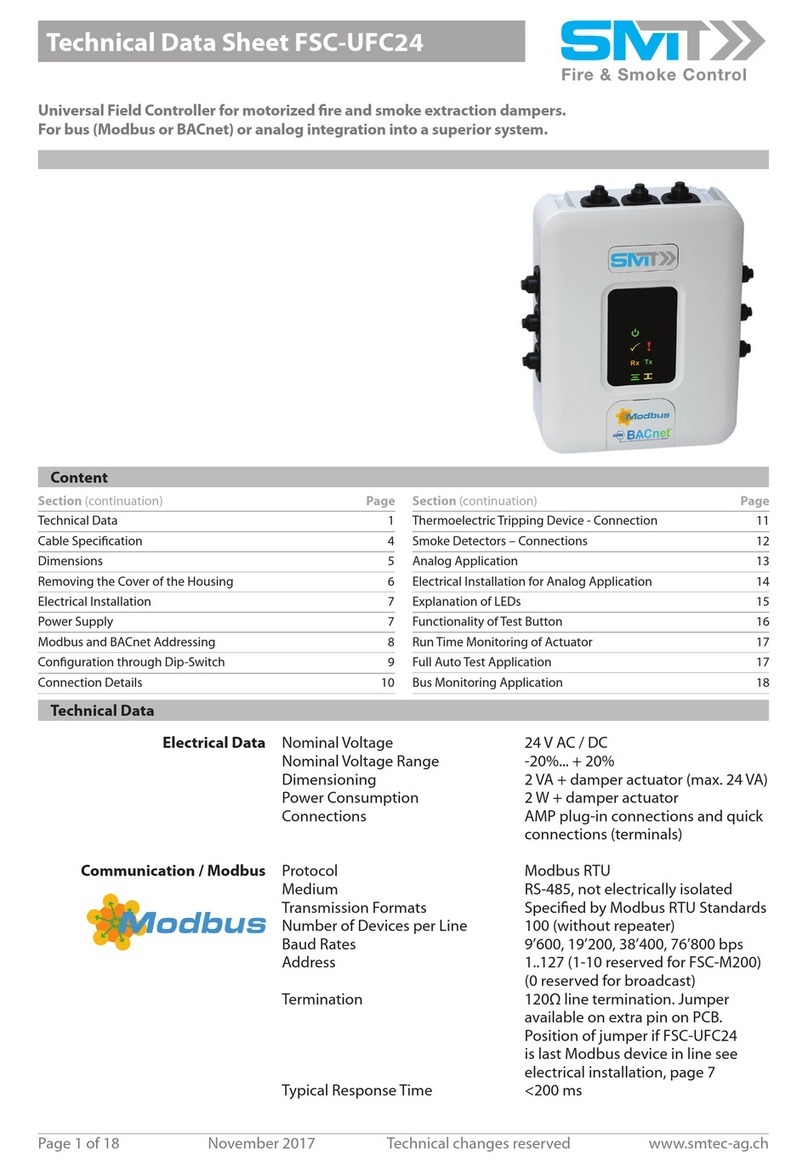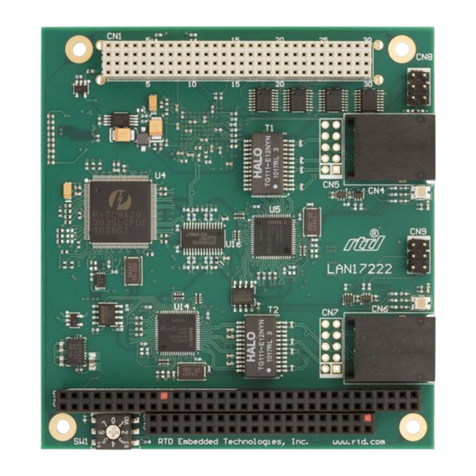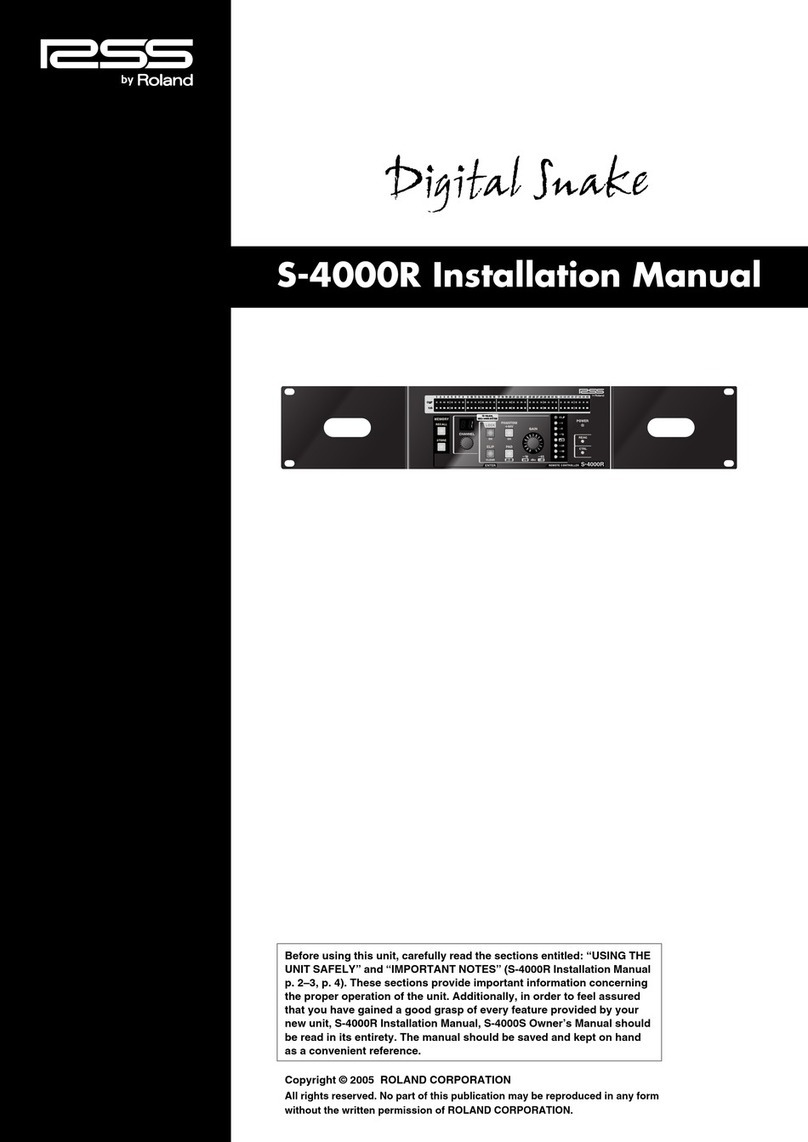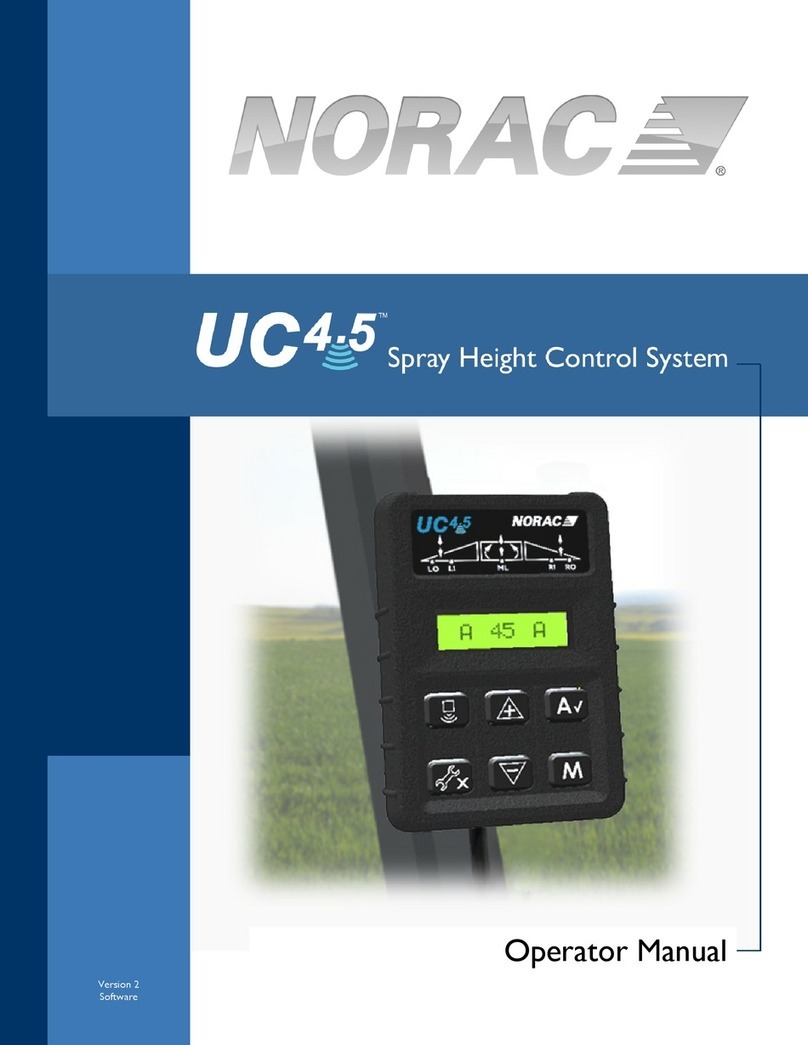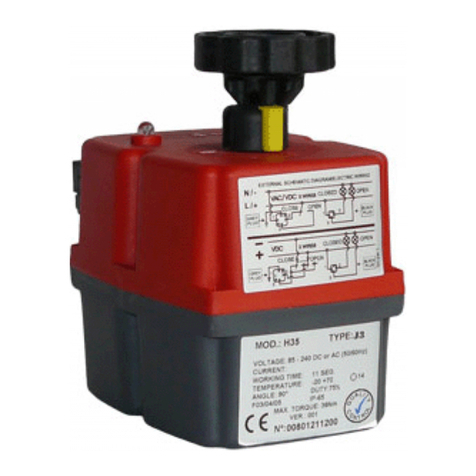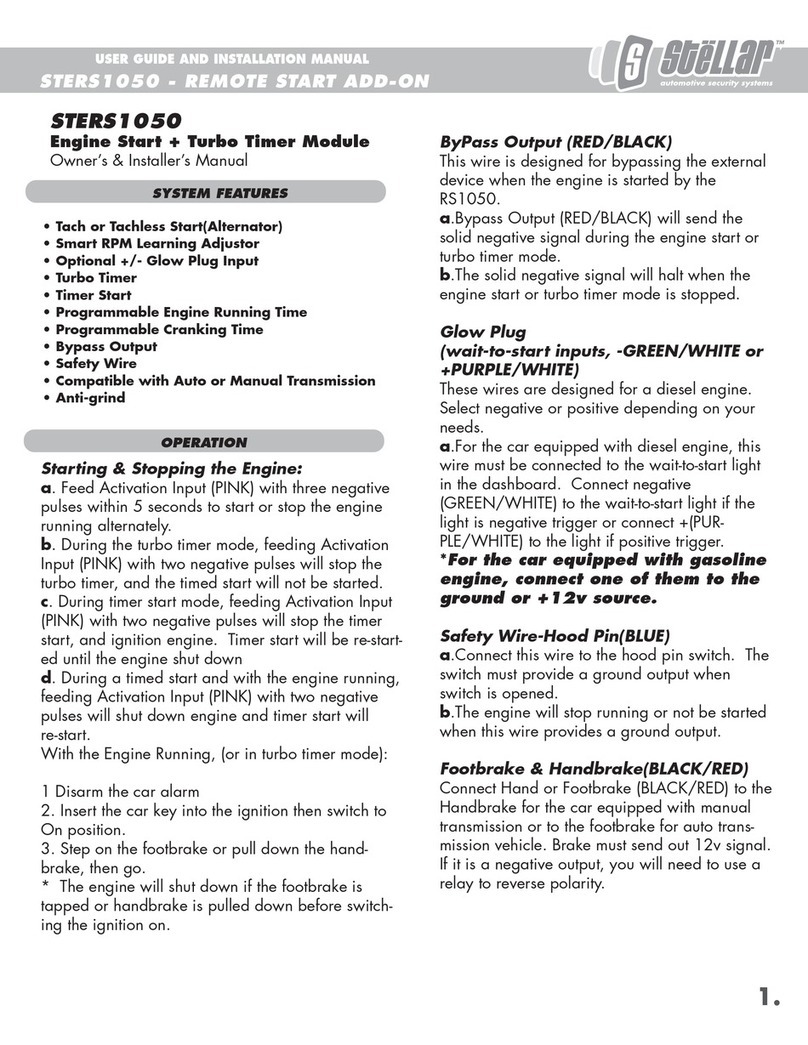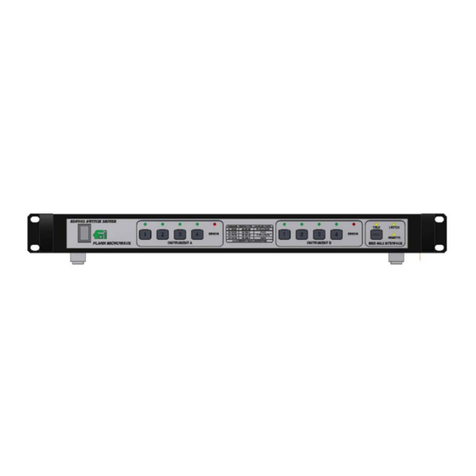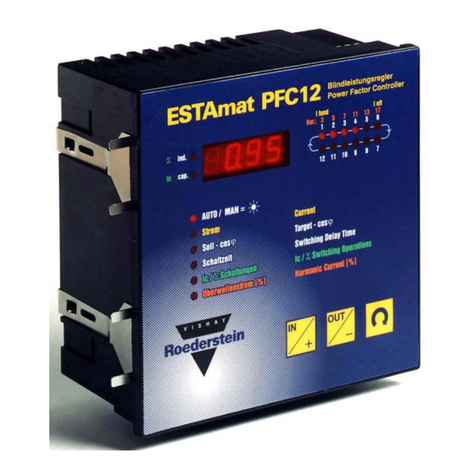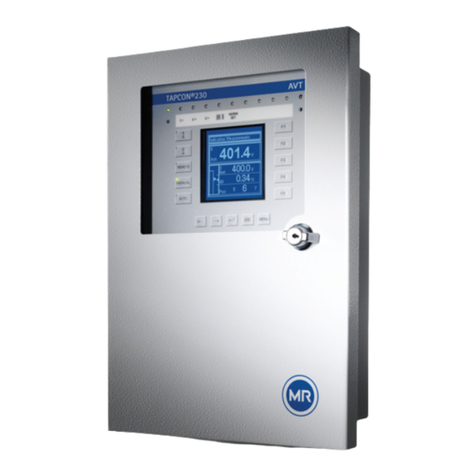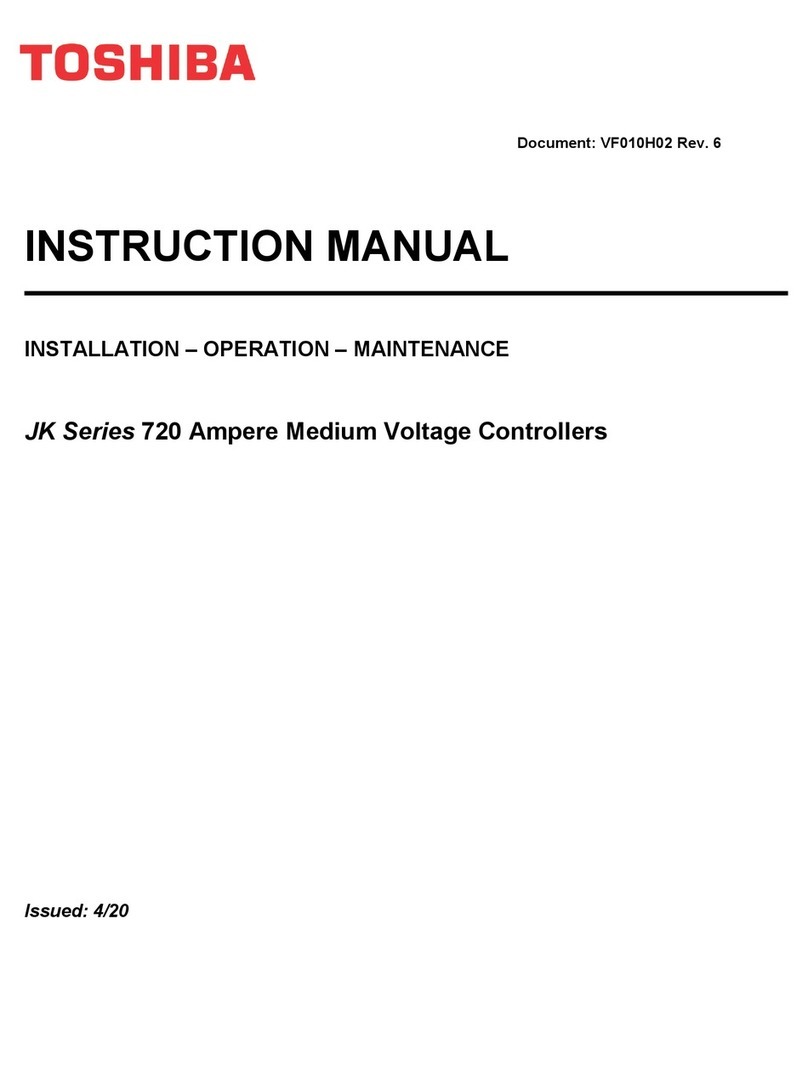Faulhaber MCDC 3603 Series User manual

MCDC 3603 MCBL 3603
Series
Operating Instructions
Brushless DC-Servomotors
Motion Controller
4-Quadrant PWM for DC-Micromotors and
Series
Edition 20.02.2001

Surf to the following Internet
address and you will find the
latest edition of the instruction
manual on-line: www.minimotor.ch/uk/pr/
For direct Download:
w
w
w
.
f
a
u
l
h
a
b
e
r
.
c
o
m
Miniature Drive Systems
Micro Drives
DC-Micromotors
Precision Gearheads
Servo Components
Drive Electronics
http://www.minimotor.ch/minicatalog/pdf/DriveCircuits/Manuals/IM_e_MCDC_MCBL_3603.pdf

Index
Chapter Page
1. Description 2
2. Model overview 3
3. Technical information 4
4. Dimensions 5
5. Start-up Procedure 6
6. Connection diagram for MCBL 3603 7
7. Connection diagram for MCDC 3603 8
8. Software start-up 9-10
9. Pre-defined set up values 11-12
10. On line control 13-16
11. System parameter set-up 17
12. Programming 18-24
13. Typical program example 25-29
14. Program loading, saving, verification and installation 30
15. Loading an application program from the computer to the motion controller 30
16. Saving the motion controller application on disk 31
17. Verification of installed version 31
18. Installation of new (up-date) basic program 32
19. Call up program from normal inputs 33
20. Call up program from binary coded digital inputs 34
21. Example of sequential multi-axis application 35
22. Analogue input command 36
23. Stepper motor emulation 37
24. RS485easy-Bus 37-38
25. Trouble-shooting 39
26. Operating system error 39
27. General usage instructions 40
28. Hardware 41
29. Pin configuration 42-45

2Specifications subject to change without notice
Description
1. Description
The MCBL 3603 and the MCDC 3603 are very compact motion controllers ideal for our
brushless DC-Servomotors and brushed DC-Micromotors.
Each model comprises a PWM servo amplifier.
Technology
Both motion controllers are based on a fast, powerful 16 bit microcomputer system.
This guarantees high dynamics, precise positioning and quiet running, regardless of the
motor type used.
The well thought-out design and consistent application of SMD technology ensures a very
compact device. The specially developed user software offers high flexibility and simple
handling.
Application field
Developed with the use of state-of-the-art technology, the motion controllers are suitable
for a wide range of applications: insertion and handling machines, machine tools, robots,
X/Y tables, drive and automation systems in medical technology, chemical and food
industry, etc.
Programming
One of the most important objectives in the development of these units was to keep its
operation as simple as possible. This has been attained with the use of just a few, highly
efficient functions.
Manual balancing or potentiometers are no longer required. Menu-guided program and
parameter-editing functions are already integrated for operation with an ASCII terminal.
In place of internal menu management, the clearly structured command set can be simply
integrated into a customer-specific interface, e.g. with Visual Basic, Lab View, Pascal, C++,
etc.
Any PC with Windows operating system can be used as an input terminal. Program up-
dates are made directly via the serial interface without changing the hardware.
Communication is made via the serial port RS232 or RS485.

Model overview
2. Model overview
MCBL 3603 Integrated PWM
servo amplifier 36V-3A Brushless DC-Servomotors
with encoder
MCDC 3603 Integrated PWM
servo amplifier 36V-3A Brushed DC-Micromotors
with encoder
MENUE
SET UP
HOME FUNCTION
PROGRAM INDEX
PROGRAM MOTION
UP DATE PROGRAM
SAVE/LOAD APPLICATION
SWITCHED POWER SUPPLY 5V, 12V INTERNAL
PLC LOGIC
INPUT FUNCTION
BCD-CODED PROGRAM
POWER DC
QUADRATURE
COUNTER
REMOTE CONTROL
PROGRAM 1-15
ANALOGUE,
PULSE DIR,
A/B ENC 2
(OPTIONAL)
RS232
RS485easy-Bus
ACCELERATION
SPEED
POSITION
PROPORTIONAL
INTEGRAL
DERIVATIVE
f(P,I,D)
POWER STAGE
COMMUTATI ON
LOGIC
CURRENT
SENSOR
12 INPUT
DIGITAL
DIFFERENTIATOR
8 OUTPUT
DIGITAL
CH B
HA B
HA C
CH A
SWITCHES
HOME SENSOR
LIMIT SENSOR
EMERGENCY CIRCUIT
EXTERNAL PLC
ECT
VALVE
RELAY
EXTERNAL PLC
ECT.
CURRENT LIMIT
I Peak
I Nominal
VELOCITY
f(V) f(I)
TEMP SENSOR
OVER VOLT
MONITOR
BALLAST CIRCUIT
HA A
PH A
PH B
PH C
SERVOMOTOR
BRUSHLESS
Brushless
DC-Servomotor
Encoder
RS485
OPTIONAL
MENUE
SET UP
HOME FUNCTION
PROGRAM INDEX
PROGRAM MOTION
UP DATE PROGRAM
SAVE/LOAD APPLICATION
SWITCHED POWER SUPPLY 5V, 12V INTERNAL
PLC LOGIC
INPUT FUNCTION
BCD-CODED PROGRAM
POWER DC
QUADRATURE
COUNTER
REMOTE CONTROL
PROGRAM 1-15
ANALOGUE,
PULSE DIR,
A/B ENC 2
(OPTIONAL)
RS232
RS485easy-Bus
ACCELERATION
SPEED
POSITION
PROPORTIONAL
INTEGRAL
DERIVATIVE
f(P,I,D)
POWER STAGE
CURRENT
SENSOR
12 INPUT
DIGITAL
DIFFERENTIATOR
8 OUTPUT
DIGITAL
CH B
CH A
SWITCHES
HOME SENSOR
LIMIT SENSOR
EMERGENCY CIRCUIT
EXTERNAL PLC
ECT
VALVE
RELAY
EXTERNAL PLC
ECT.
CURRENT LIMIT
I Peak
I Nominal
VELOCITY
f(V) f(I)
TEMP SENSOR
OVER VOLT
MONITOR
BALLAST CIRCUIT +
SERVOMOTOR
BRUSHLESS
DC-Micromotor
Encoder
RS485
-
OPTIONAL
Specifications subject to change without notice
3

3. Technical data
Technical information
Communication data
Temperature rating
Operating temperature
Storage temperature
Weight / Dimensions
Weight: 130
Dimensions: see diagram on page 5
0 ... + 55
-20 ... + 80
4
256 x 8 256 x 8
500 500
15 15
50 50
50 50
Supply voltage
PWM switching frequency
Max. continuous output current
Max. peak output current
Max. encoder frequency
Electrical data
12 ÷36 12 ÷36
20 20
33
10 10
200 200
Software data
Program memory (16 bit access)
Sampling period
Number of programs
Lines per program
Number of indexes
MCBL 3603 MCDC 3603
RS232 / RS485 / RS485easy-Bus
3 LED's
12 (optional)
8 (optional)
integrated ASCII terminal
via serial interface
via serial interface
via encoder Z-index / via external sensor
Interface
Status display
Optional inputs (5V pull-up standard,
24V pull-down on request)
Optional outputs (6 x 50V/500mA open
collector, 2 x TTL level)
Program and parameter editor
Program up-date
Application and parameter save / load
Starting position function
V DC
kHz
A
A
kHz
kbyte
µs
°C
°C
g
Specifications subject to change without notice

5
Dimensions
4. Dimensions for MCBL 3603 and MCDC 3603
105
75
3,2
35
10,5
7,5
99,2 2,9
3
66,7
1234
5
Scale reduced
Connection for MCBL 3603
Power supply motor / motor connection
Encoder 1) and Hall sensors
Input for special function
RS232
Optional digital Input / Output
1
2
3
4
5
Connection for MCDC 3603
Power supply motor / motor connection
Encoder 1)
Input for special function
RS232
Optional digital Input / Output
1) Line driver encoders for noisy environments or long distances can be used.
Specifications subject to change without notice
1
2
3
4
5

6
Start-up Procedure for MCBL 3603
Start-up procedure
Here we list a step-by-step start-up procedure for both the electrics and software.
Also included are several examples in order to allow the user to test the unit and
familiarise himself with programming.
We therefore recommend that this sequence is followed for trouble-free installation:
• Connect the motor phases to MOTOR
• Connect the encoder and the motor Hall sensor leads to ENCODER HALL
• Connect the RS232 (or RS485) to the computer port COM
• Connect the power supply to PWR
• Power the motion controller
• Software start-up
Start-up Procedure for MCDC 3603
• Connect the motor terminals to MOTOR
• Connect the encoder to ENCODER
• Connect the RS232 (or RS485) to the computer port COM
• Connect the power supply to PWR
• Power the motion controller
• Software start-up
The computer link is necessary to program the motion controller.
After programming has been completed, the computer link can be disconnected since the
programs can be started using the motion controller input functions.
5. Start-up procedure
For advanced functions such as:
• Analogue input command
• Stepper motor emulation
• RS 485 serial interface
• Multi-axis operation
please refer to the specifique chapters
Specifications subject to change without notice

7
Start-up procedure
6. Connection diagram for MCBL 3603
PWR
MOTOR COM1
Computer cable
RS232 / RS485
RS485easy-Bus*
PLC I/O (12 inputs / 8 outputs)
1 GND
9 Hall sensor A
11 Hall sensor B
13 Hall sensor C
15 Vcc logical (5 VDC)
1 GND
7 Z index (if no index NC)
3 B channel
5 A channel
2 Vcc logical (5 VDC)
Encoder
1 GND
2 Power Supply (12-50 VDC)
3 Phase A
4 Phase B
5 Phase C
Brushless
DC-Servomotor
ENCODER HALL OPTIO
optional digital I/O
COMPUTER INPUT
*optional adapter for
RS 485easy-Bus
11
515
610
11 15
Specifications subject to change without notice

8
Start-up procedure
PWR
MOTOR COM1
Computer cable
RS232 / RS485
RS485easy-Bus
*
PLC I/O (12 inputs / 8 outputs)
1 GND
7 Z index (if no index NC)
3 B channel
5 A channel
2 Vcc logical (5 VDC)
Encoder
1 GND
2 Power Supply (12-50 VDC)
3 Motor (-)
4 Motor (+) DC-Micromotor
ENCODER OPTIO
optional digital I/O
COMPUTER INPUT
*
optional adapter for
RS 485easy-Bus
1
1
515
610
11 15
PLC I/O description
The PLC I/O port enables direct communication with the position control function without
having to use a computer. For example, once a program has been created, it can be
executed by simply giving a command to the assigned input. In the initial phases of
installation, and to allow the user to better understand the operation of the motion
controller, all instructions are given via computer. It is therefore not necessary to connect
this port.
RS232 description
This port is the communication link between the motion controller and the external
computer via the COM1 connection point. Additional information regarding the
connection and set-up is given in chapter 29. The link is make with a standard
computer cable which, if necessary, can be optionally supplied by Minimotor.
7. Connection diagram for MCDC 3603
Specifications subject to change without notice

Start-up procedure
8. Software start-up
If this does not happen, you should first check all the connections. If the above menu still
does not appear on the screen, you should re-install the software program xx36_yyy.S19.
Instructions for this procedure can be found in chapter 18.
At this point, the start-up procedure is complete. The unit is now ready to be programmed
for its specific application.
The diskette supplied with the motion controller contains:
installation program
program xx36_yyy.S19 (basic motion controller software)
terminal emulator for Windows
program MM_WIN.TRM with the pre-defined terminal emulator parameters
• To copy the software onto your hard disk using Windows, first of all start the
installation program from the DOS prompt which copies the contents of the diskette
into a directory MIMO_MC which is automatically created.
You should now work only on your hard disk. The diskette now serves as a back-up
for security purposes only.
• Go to the MIMO_MC directory and open the file TERMINAL.EXE.
• Go to FILE menu and open MM_WIN.TRM.
• Press MENU button on the screen. The following menu will appear:
Specifications subject to change without notice
9

10
General software information
Terminal emulator description
The computer is only used as a terminal. The terminal emulator therefore enables
communication between the computer and motion controller software. The actual
programming is made directly in the motion controller itself.
Display Description
LED 1 Internal 5V power supply OK
LED 2 Software OK
LED 3 Servo OK, system closed
LED 3 blinking Error, ask error code, see troubleshooting chapter 27
Motion controller software organisation
The software is constructed on three different levels.
• Operating system
The operating system normally remains invisible to the user and is a background
function for:
– download functions
– back-up in emergency situations
For additional information, see chapter 26.
• Program xx36_yyy.S19
Is the basic working program which realises all described functions and programming
possibilities. This program is already installed within the unit and automatically goes
into operation once the system is started-up.
• Application user programs
Contains the complete set of customer-defined data and parameters (= “application”).
General instructions on how to move, insert, delete, etc. within the program:
• Close every entry with the command <ENTER>
• Text can be entered using either small or capital letters
• Use the arrows to move up and/or down the menu lines
• To go back to the previous menu always use <ESC>
• Close erroneous entries with <ENTER> and re-enter data
Delete characters Back Space
Clear line <CRTL C>
Insert line <CRTL I>
Page down <CRTL D>
Page up <CRTL U>
LED status
General programming instructions
Specifications subject to change without notice

Set up values
9. Pre-defined set up values
The SET UP VALUES menu contains all the necessary parameters for the unit to function
according to the specific application.
The motion controller has default parameters which allows it to run the majority of motors
stably, allowing the user to fine-tune the unit’s operation without the risk of causing
damage.
For optimum operation it is of course necessary for the individual parameters to be set
according to the requirements of the specific application. A description on how to optimise
the system is contained in chapter 11.
As an initial step the user should familiarise himself with the motion controller instructions
which are available via the ON LINE CONTROL menu. As we will see later, it is important to
first get the motor running before optimising the parameters.
Attention!
Before giving any instructions to the motor, ensure that it is first running without load
since the current limiter is not set to the maximum motor current.
Specifications subject to change without notice
11

12
Set up values
Description
I NOM Nominal current
I PEAK Peak current
PROPORTIONAL Proportional closed loop parameter (stiffness)
INTEGRAL Integral closed loop parameter (positioning precision)
DERIVATIVE Differential closed loop parameter (stability, dynamic)
VELOCITY Velocity closed loop parameter (oscillation prevention)
INC PER PULSE Increment (lines) per pulse in MODE 2 or 12 for stepper
emulation function (see chapter 23)
DEVIATE POS Permissible max. position deviation in lines
PROFILE ROUND To smooths the speed profile out (see below)
INPUT H-ACTIVE 0=Input active low, I=Input active
ANALOG FUNCTION Analog function active with mode 3 or 13 for digital speed control.
0=CW (+), I=CCW (-), 2=Cw and CCW (+/-)
By setting to profile round, the speed profile is smoothed out,
this reducing mechanical stress for better live performance.
MODE 0 = Programs and commands operated using the standard
inputs (see chapter 19)
2 = Programs and commands operated using the standard
inputs. PULSE/DIRECTION input signal for stepper
control emulation function active (see chapter 23)
3 = Programs and commands operated using the standard
inputs. Analogue input signal for digital speed control
function active (see chapter 22)
10 = Programs operated using the 4 binary coded inputs
and input 8 as starting trigger (see chapter 20)
12 = Programs operated using the 4 binary coded inputs
and input 8 as starting trigger. Stepper control
emulation function active (see chapter 23)
13 = Programs operated using the 4 binary coded inputs
and input 8 as starting trigger. Analogue input signal
for digital speed control function active (see chapter 22)
t
v
t
v
profile round
10 = 5 ms
100 = 50 ms
Specifications subject to change without notice

13
On line control
10. On line control
10.1 Execute functions
The EXECUTE FUNCTIONS menu only lists a selection of the most important available
instructions. However, other functions can be executed via this menu.
Specifications subject to change without notice

Parameter
On line control
Command
AC
AIX
CI
CO
DIX
DP
DV
EC
ED
GP
GW
GZ
HO
IN
IP
IT
IX
JP
JN
JNZ[letter]
NIX
PG
PO
PP
PQ
PW
PWC
RI
RR
RW
SET[letter]
SIX
SM
SO
SP
TE
TI
TP
TS
VL
WA
WT
Acceleration
Overwrite acceleration index at preloaded NIX
number by remote control
Card identifier for RS485easy-Bus
Clear output
Overwrite distance index at preloaded NIX
number by remote control
Permitted position deviation in lines
Differential closed loop parameter
Encoder counter on-line diagnosis
Emergency deceleration with Exit function EE
and Limit-switch function LL and LR
Go to position (absolute)
Go way (relative)
Go to Z-index (encoder)
Home function according to program
Nominal current
Peak current
Integral closed loop parameter
Run index # according to program
Jog (run) positive, constant speed
Jog (run) negative, constant speed
Indicate loop reference letter (from A to E).
Decrements the loop repeats, whereby if not
zero, jump to line xx
Number index pre-load for changing index
parameters by remote control
Run program #
Position (absolute)
Proportional closed loop parameter
Servo amplifier power OFF
Power ON, reset position counter
Power ON continue, keep position counter
Required identifier for RS485easy-Bus
Repeat way CW/CCW
Repeat way (same direction)
Set loop reference letter (five possibilies,
from A to E) and number of repeats xxxx
Overwrite speed index at preloaded NIX
number by remote control
Stop motion
Set output
Speed
Tell error codes 01-99
Tell status input, 0=Low 1=High
Tell actual position ±2*10E9
Tell status:
0 = power OFF
1 = power ON
2 = moving
3 = program active
9 = error
Velocity closed loop parameter
Way (relative)
Waiting time
Description
1 000 - 4 000 000 lines/s
2
10 - 50 000 (x 1 000) lines/s
2
0-100
1 - 8
±2 000 000 000 lines
lines
0 - 50
1 000 - 5 000 000 lines/s
2
1 - xx
1 - xx
0 - 50
1 - 50
1 - 50
1 - 50
1 - 15
±2 000 000 000 lines
1 - 50
0 - 100
1 - 10 000
1 - 10 000
1 - 10 000
25 - 1 000 000 lines/s
1 - 8
25 - 1 000 000 lines/s
? or 1 - 12
0 - 50
±2 000 000 000 lines
x 10 ms
Specifications subject to change without notice14

15
On line control
Here are some examples of how the system’s performance can be controlled:
10.2 Motion values
As well as describing the function of the MOTION VALUES menu, there is also a graphical
description of how a speed profile can be programmed.
> PW <ENTER> The motor is stationery and maintains its position.
> JP <ENTER> The motor runs at a constant CW speed.
> SP10000 <ENTER> The motor runs at 2 500 lines/s.
> EC <ENTER> The encoder counter value appears on the screen.
To return to the previous menu, press ESC.
> SM <ENTER> The motor stops and maintains its position.
> PQ <ENTER> The power stage is switched off.
Specifications subject to change without notice

16
On line control
ACCEL Acceleration in lines per second2
SPEED Speed in lines per second
WAY Way in lines (relative) for RR and RW instructions
POSITION Position in lines (absolute)
WAIT REPEAT Wait time for RR and RW instructions
Parameters graphic explanation (example with RW)
time
speed (lines /s)
speed
Wait repeat
0
TACCEL
ACCEL = SPEED / T
ACCEL
Encoder resolution
Using the two encoder channels, the motion controller internal electronics multiply the
encoder resolutions by 4. For example, when using a 500 line incremental encoder, one
revolution of the motor shaft corresponds to 2 000 lines.
Therefore WAY 2 000 corresponds to one motor shaft revolution.
Acceleration and deceleration
When setting the acceleration, the system automatically sets the deceleration to the same
value.
Specifications subject to change without notice

Set-up values
11. System parameter set-up
Current limiter set up
The current limits I NOM and I PEAK must be set according the motor used.
The value of I NOM should not exceed the motor’s recommended current for continuous
operation.
I NOM limit is only active during constant speed operation.
I PEAK limit is only active during acceleration and deceleration.
Optimising the closed loop parameters
The closed loop system can be optimised by running the motor (including assembled
mechanical parts) directly on line and by adjusting the following parameters via the SET UP
VALUES menu:
PROPORTIONAL (1 - 50)
INTEGRAL (0 - 50)
DERIVATIVE (0 - 50)
VELOCITY (0 - 50)
This optimisation is best carried out by running the motor with the RW and/or RR
instructions.
When executing these instructions, all parameters (even set-up) can be changed on line,
thus enabling the user to see the reaction of the system whilst making changes. One helpful
function is the EC (encoder counter) which gives information on the actual motor shaft
position.
Improved dynamics
If your application requires more dynamics, this can be obtained by increasing the
PROPORTIONAL, DERIVATIVE and VELOCITY LOOP values (e.g. to 10, 20 and 20).
If the motor is noisy or vibrates (indicating system instability), these parameters should be
reduced.
Precise positioning
If you need to improve the motor’s position holding, an INTEGRAL value should be given
(e.g. 5). The INTEGRAL value is only activated when the motor reaches the requested
position. In this way the system’s dynamic is not influenced by this value.
To control the exact position of the motor, the EC (encoder counter) command is used via
the ON LINE CONTROL menu.
Specifications subject to change without notice
17

18
Programming
12. Programming
Here we look into the individual PROGRAMMING menus of the system.
Practical examples of how the motion can be controlled are to be found at the end of this section.
12.1 Home function
This is the fixed reference starting (home) position. The home command can be given when
ever the system should return to the home position.
Specifications subject to change without notice
This manual suits for next models
1
Table of contents
Other Faulhaber Controllers manuals

Faulhaber
Faulhaber MCLM 300 RS Series Parts list manual
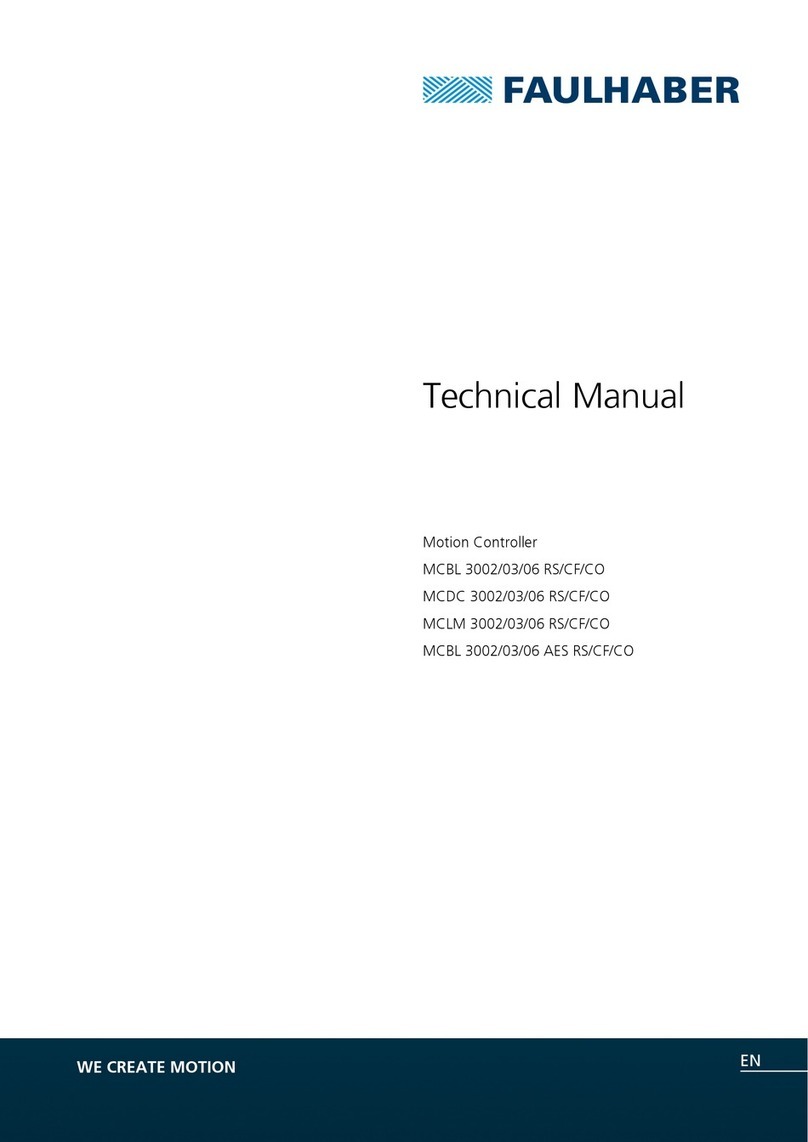
Faulhaber
Faulhaber MCDC 3002/03/06 RS/CF/CO Series User manual

Faulhaber
Faulhaber MC 5010 User manual
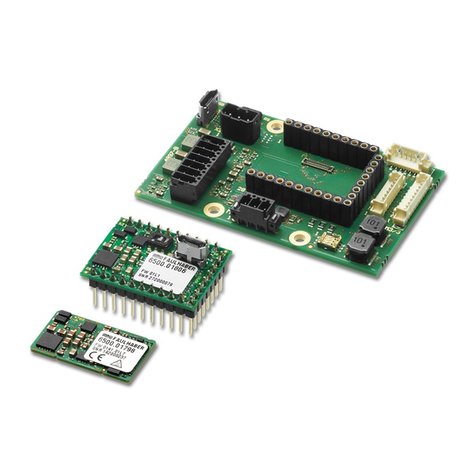
Faulhaber
Faulhaber MC 3001 B User manual
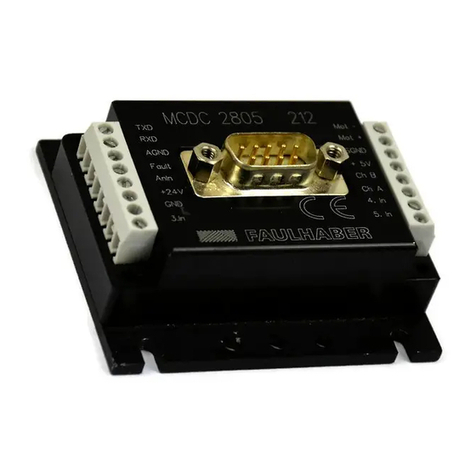
Faulhaber
Faulhaber MCDC2805 series User manual

Faulhaber
Faulhaber MC 5010 Use and care manual
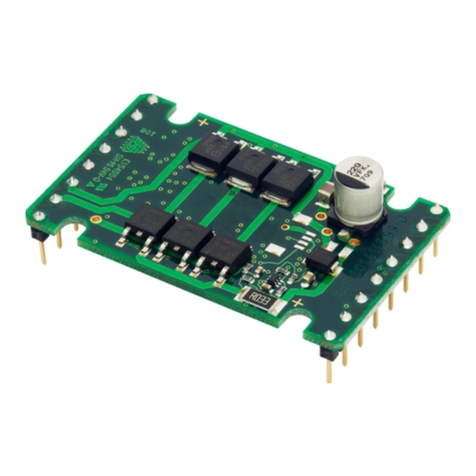
Faulhaber
Faulhaber SC 1801 User manual

Faulhaber
Faulhaber SC 1801 Series User manual

Faulhaber
Faulhaber MC 5010 Owner's manual

Faulhaber
Faulhaber MCLM 300x CO Series Parts list manual


